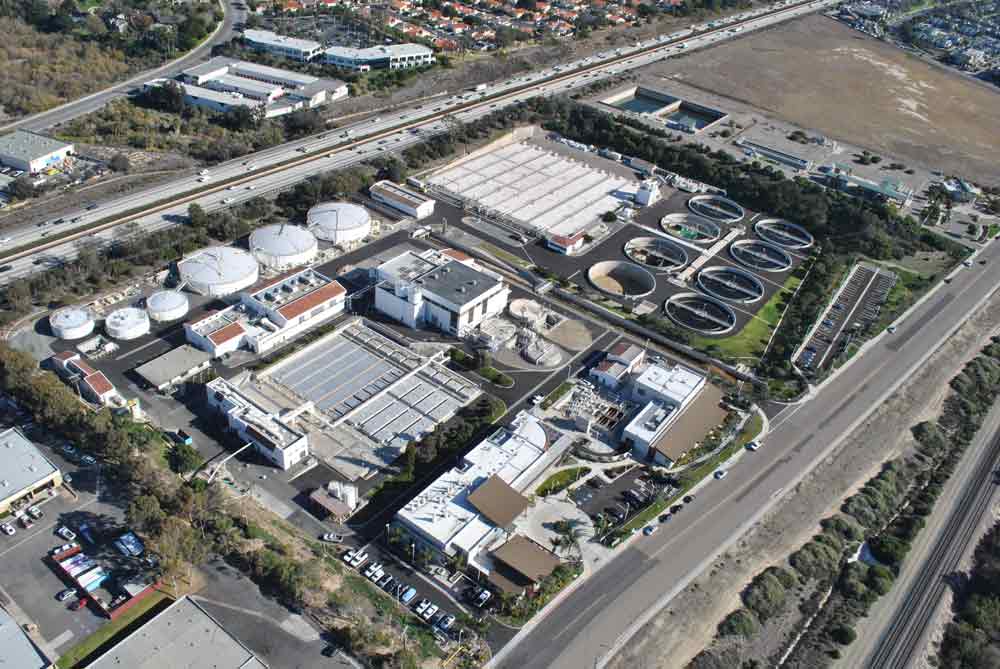
The Encina Water Pollution Control Facility (EWPCF) plays an essential role at the Encina Wastewater Authority (EWA), serving over 380,000 residents in North San Diego County. Originally constructed in the 1960s, EWPCF has evolved into a Class V wastewater treatment plant designed to handle an ultimate average dry weather flow capacity of 40.5 mgd of liquid and 43.3 mgd of solids.
Encina operates under a Joint Powers Authority (JPA) formed by six public agencies: the cities of Carlsbad, Vista, and Encinitas, the Buena Sanitation District, the Vallecitos Water District, and the Leucadia Wastewater District. This collaborative governance model enables cost-effective service delivery while ensuring long-term protection of public and environmental health. Encina’s ten Board members are appointed from their respective home agencies. Ownership is shared based on the utilization of facility resources and has remained proportionally consistent for nearly two decades.
EWPCF is located in the City of Carlsbad, just 500 yards from the Pacific Ocean. “Encina’s success is rooted in its people. The agency prioritizes staff development through continuous training, leadership opportunities, and a culture that values innovation and accountability,” said General Manager Scott McClelland. “Employees are empowered to contribute to strategic planning and operational improvements.”
Encina’s annual tactical plan is driven by strategic initiatives that align with its five-year Strategic Plan, Biosolids Management Plan, and Facility Master Plan (currently looking ahead to 2040). These frameworks ensure that every investment, whether in infrastructure or human capital, supports long-term resilience and service quality.
Initially built in 1965 as a 4.5 mgd facility, including an ocean outfall, the facility today provides a full suite of services, including tertiary water recycling, biosolids management, laboratory analysis, source control, and ocean monitoring. EWPCF utilizes a multi-stage treatment process, which includes preliminary, primary, secondary, and tertiary treatments, followed by advanced disinfection methods. Each stage uses cutting-edge technology to ensure pollutants are effectively removed and that water quality standards are consistently exceeded.
In 2024, the EWPCF achieved 100% compliance with its National Pollutant Discharge Elimination System (NPDES) permit. The facility treated an average of 23.46 mgd of wastewater, with removal efficiencies of 98.53% for Total Suspended Solids (TSS) and 98.48% for Carbonaceous Biochemical Oxygen Demand (CBOD) – far exceeding the 85% regulatory requirement. Encina also reclaimed an average of 5.21 mgd of water for in-plant use and diverted over 129 million gallons of secondary effluent to regional water reclamation partners.
Additionally, EWA is committed to the effective and efficient operation, maintenance, and administration of the EWPCF and other contract-operated facilities with a budget of just over $26 million per year.
Encina’s commitment to environmental stewardship is exemplified by its renewable energy initiatives. The facility’s cogeneration system utilizes biogas produced from municipal solids, fats, oils, grease (FOG), as well as brewery waste to generate over 80% of its electricity needs. In 2024 alone, the system generated more than one million kilowatt-hours of clean energy, accounting for 78% of the total electricity consumed.
Encina’s leadership in clean energy has earned it national recognition, ranking among the EPA’s top 30 facilities for renewable power generation.
“Strategic energy management allows us to reduce grid reliance and lowers costs for those we serve,” McClelland said. “In the future, we expect energy to be one of our greatest challenges, so the efforts we are taking now are done so with a vision of a sustainable future.”
Since 2009, the agency has used heat-drying technology to produce Class A biosolids – marketed as ‘PureGreen’ – which are used as biofuel and organic fertilizer. These high-quality pellets are distributed to nurseries, golf courses, and soil blenders, reducing transportation needs and generating revenue.
“By converting what was once waste into a valuable product, we’re closing the loop on sustainability,” said McClelland. “Encina’s biosolids program reflects its forward-thinking approach to resource recovery.” McClelland added that Encina continues to explore innovative solutions for biosolids reuse, energy efficiency, and water recycling. “But, at the core of every initiative is a steadfast commitment to its core values—safety, teamwork, integrity, responsibility, and respect—and to the people who make it all possible. Encina is proud to be given the duty to protect the public and environmental health for generations to come.”
Nominate an outstanding clean water professional or agency—at awards.cwea.org.